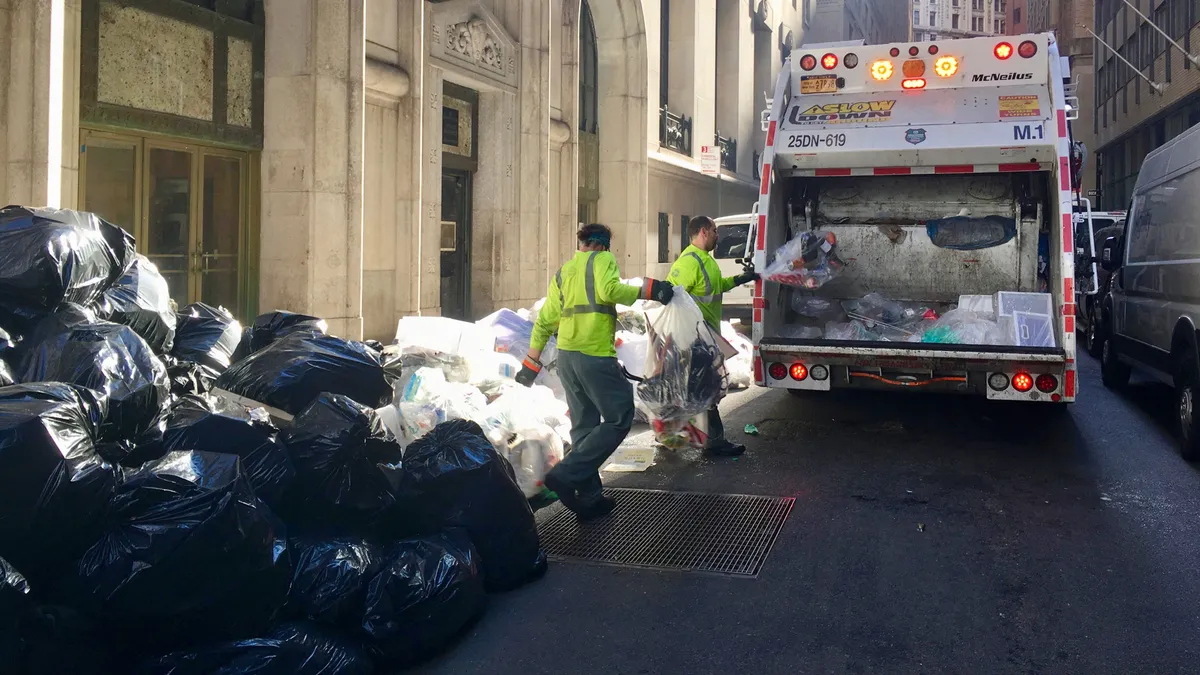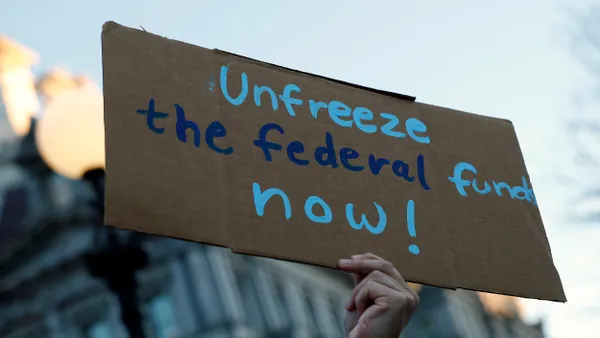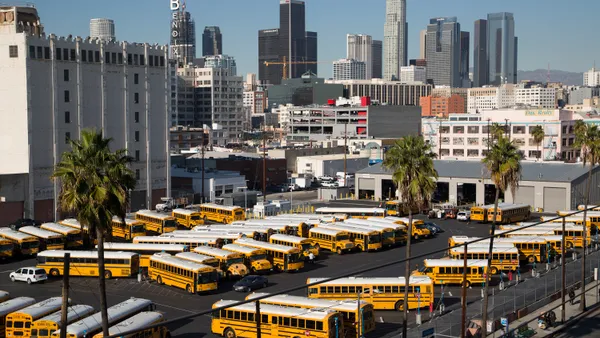Dive Brief:
- A new "Put Waste to Work" campaign calls for New York Mayor-elect Eric Adams' administration to take a multiagency approach to tackling waste issues. The plan, authored by the Center for Zero Waste Design and architecture firm WXY, contains three core pillars: circulate, contain and compost.
- Improving street cleanliness is a key focus. The plan calls on the city's Department of Sanitation (DSNY) to optimize its collection routing, scale up the use of on-street or sidewalk containers for aggregated collection, retrofit its fleet to support the collection of submerged or surface containers, place related requirements on large buildings and much more.
- During a Nov. 16 city council hearing, DSNY Commissioner Edward Grayson said the agency would advance a "small scale" test of its Clean Curbs containerization program and finalize a proposed rule soon for new, large residential buildings to develop waste management plans. The agency will also pilot a network of "unstaffed and automated food scrap drop-off bins controlled with a smart phone or RFID card" in select Manhattan and Queens neighborhoods.
Dive Insight:
Towering mounds of garbage bags are an infamous sight on New York sidewalks, but efforts to change this have seen limited progress in recent years. Mayor Bill de Blasio's goal to achieve "zero waste" by 2030 has also stalled, by many accounts, leading some observers to hope a new administration can change course by revitalizing energy and collaboration across city agencies to address these issues.
The team behind this new campaign said the updates DSNY gave at the recent council hearing were positive, but they added in recent testimony that "there is so much more that needs to be done."
Clare Miflin, founder of the Center for Zero Waste Design, has been among those driving discussion on this topic with prior leadership on proposed zero waste architecture design guidelines and other efforts. Looking ahead with the new plan, she believes it's time for a fresh approach that can help agencies focused on sanitation, transportation, buildings, parks and other areas break out of their current silos.
“It has to come from the mayor’s office," said Miflin, adding that such efforts can be part of shared goals such as improving equity in street conditions, mitigating rodent issues and driving more local economic development opportunities. “As we transition to a circular economy it’s not goods in, waste out. It’s a far more circular loop.”
Some of the Put Waste to Work plan's ideas have been advocacy priorities for years, such as exploring a save-as-you-throw program, making residential organics recycling mandatory, supporting the use of pneumatic tubes in certain areas and developing a larger network of drop-off centers for streams such as textiles and electronics. While enacting some of this is often presented as a question of political will and funding, the proposal's authors say it doesn't have to be so complicated.
"If you could implement these recommendations, this would save the city money," said Claire Weisz, principal-in-charge of WXY, adding that "the containers are kind of the key and could unlock a lot of things."
This is a common approach around the world, with European hubs such as Barcelona especially well-known for innovative containerization infrastructure above and below ground. New York's tight sidewalks, hotly contested street space and limited number of back alleys are often cited as key impediments.
But the team behind this proposal says initial progress could easily be made by looking to models used in New York neighborhoods such as Battery Park City, requiring existing buildings to also develop new waste management systems, establishing more practical design standards to accommodate roll-on/roll-off compactor collection, rethinking collection schedules to prioritize higher density areas and incentivize diversion, and having DSNY's rear-load trucks also use hoists to collect small containers where applicable.
“Using hoists is something [DSNY] used to do, it’s something the carters do as a matter of routine," said Ben Miller, a co-author of the plan and former DSNY policy official, in reference to how some commercial waste haulers collect waste. While DSNY handles residential collection, private companies handle commercial collection in a system set for major change starting next year.
Miller said he believes DSNY's uniform staff is supportive of containerization efforts and multiple former commissioners "heartily support what we’re doing." Norman Steisel — a former DSNY commissioner and deputy mayor — is among that group.
"The new mayor is going to be facing a very daunting budget process," he said, referencing the expected need for budget savings in New York's future. “It’s worth making an effort to do it, and they constantly have to be focused on how to reform things and make things better. Now they have the added cost imperative."
While Adams has previously said he supports some form of citywide organics collection, little else is known about how his administration may approach waste and recycling issues. In the meantime, incremental progress continues in the final weeks of de Blasio's tenure.
"We welcome ideas from residents and stakeholders that would bring us closer to our Zero Waste goals and further our missions of ensuring clean, safe streets for all New Yorkers," said DSNY Press Secretary Vincent Gragnani via email, in response to the new proposal. "We look forward to the continuing expansion of curbside organics collection, food-scrap drop-off sites, and our new smart bins for compost collection, as well as textile recycling programs, food waste education and other initiatives."
The Clean Curbs pilot and containerization ideas continue gaining traction, as seen with recent support from the New York Daily News editorial board and Council Member-elect Erik Bottcher of Manhattan.
“The sanitation crisis has reached a boiling point and New Yorkers are no longer accepting of the status quo,” said Bottcher, who made a waste platform part of his campaign and hopes to chair the council's sanitation committee next year, via email. “My neighbors and I are tired of walking by mountains of trash on the sidewalk. We need to focus on producing less landfill waste and reforming our storage and collection procedures. Our city should be embracing the common sense strategies that are used elsewhere and adapting them for use in New York City.”
A recent exchange during the sanitation committee's latest hearing may offer a preview of the political discussions ahead for making containerization happen on a large scale.
"People want something to be done with garbage as long as it’s not in front of their house," said DSNY's Grayson. "There is definitely a better way to do set-outs and talk about that, but I think it’s a far-reaching conversation."
In response, Council Member Antonio Reynoso — outgoing sanitation committee chairman and Brooklyn borough president-elect — said he will be among those working to see this happen "sooner than later" because he believes “containerized waste is the future."













